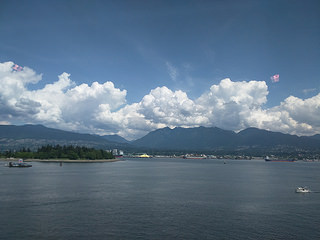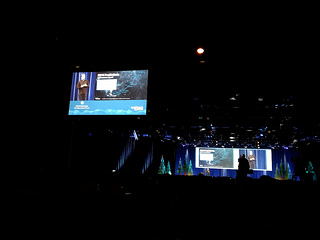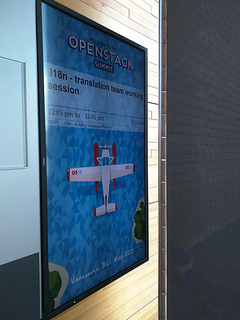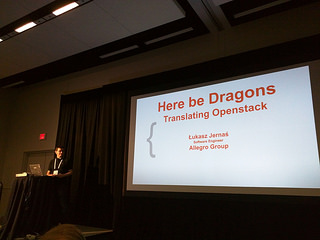This week I’m at the OpenStack Summit. It’s the most wonderful, exhausting and valuable-to-my-job event I go to, and it happens twice a year. This time it’s being held in the beautiful city of Vancouver, BC, and the conference venue is right on the water, so we get to enjoy astonishing views throughout the day.
Jonathan Bryce Executive Director of the OpenStack Foundation kicked off the event with an introduction to the summit, success that OpenStack has built in the Process, Store and Move digital economy, and some announcements, among which was the success found with federated identity support in Keystone where Morgan Fainberg, PTL of Keystone, helped show off a demonstration. The first company keynote was presented by Digitalfilm Tree who did a really fun live demo of shooting video at the summit here in Vancouver, using their OpenStack-powered cloud so it was accessible in Los Angeles for editorial review and then retrieving and playing the resulting video. They shared that a recent show that was shot in Vancouver used this very process for the daily editing and that they had previously used courier services and staff-hopping-on-planes to do the physical moving of digital content because it was too much for their previous systems. Finally, Comcast employees rolled onto the stage on a couch to chat about how they’ve expanded their use of OpenStack since presenting at the summit in Portland, Oregon Video of the all of this available here.
Next up for keynotes was Walmart, who talked about how they moved to OpenStack and used it for all the load on their sites experienced over the 2014 holiday season and how OpenStack has met their needs, video here. Then came HP’s keynote, which really focused on the community and choices available aspect of OpenStack, where speaker Mark Interrante said “OpenStack should be simpler, you shouldn’t need a PhD to run it.” Bravo! He also pointed out that HP’s booth had a demonstration of OpenStack running on various hardware at the booth, an impressively inclusive step for a company that also sells hardware. Video for HP’s keynote here (I dig the Star Wars reference). Keynotes continued with one from TD Bank, which I became familiar with when they bought up the Commerce branches in the Philadelphia region, but have since learned are a major Canadian Bank (oooh, TD stands for Toronto Dominion!). The most fascinating thing about their moved to the cloud for me is how they’ve imposed a cloud-first policy across their infrastructure, where teams must have a really good reason and approval in order to do more traditional bare-metal, one off deployments for their applications, so it’s rare, video. Cybera was the next keynote and perhaps the most inspiring from a humanitarian standpoint. As one of the earliest OpenStack adopters, Cybera is a non-profit that seeks to improve access to the internet and valuable resources therein, which presented Robin Winsor stressed in his keynote was now as the physical infrastructure that was built in North America in the 19th and 20th centuries (railroads, highways, etc), video here. The final keynote was from Solidfire who discussed the importance of solid storage as a basis of a successful deployment, video here.
Following the keynotes, I headed over to the Virtual Networking in OpenStack: Neutron 101 (video) where Kyle Mestery and Mark McClain gave a great overview of how Neutron works with various diagrams showing of the agents and improvements made in Kilo with various new drivers and plugins. The video is well worth the watch.
A chunk of my day was then reserved for translations. My role here is as the Infrastructure team contact for the translations tooling, so it’s also been a crash course in learning about translations workflows since I only speak English. Each session, even unrelated to the actual infrastructure-focused tooling has been valuable to learning. In the first translation team working session the focus was translations glossaries, which are used to help give context/meaning to certain English words where the meaning can be unclear or otherwise needs to be defined in terms of the project. There was representation from the Documentation team, which was valuable as they maintain a docs-focused glossary (here) which is more maintained and has a bigger team than the proposed separate translations glossary would have. Interesting discussion, particularly as my knowledge of translations glossaries was limited. Etherpad here: Vancouver-I18n-WG-session.
I hosted the afternoon session on Building Translation Platform. We’re migrating the team to Zanata have been fortunate to have Carlos Munoz, one of the developers on Zanata, join us at every summit since Atlanta. They’ve been one of the most supportive upstreams I’ve ever worked with, prioritizing our bug reports and really working with us to make sure our adoption is a success. The session itself reviewed the progress of our migration and set some deadlines for having translators begin the testing/feedback cycle. We also talked about hosting a Horizon instance in infra, refreshed daily, so that translators can actually see where translations are most needed via the UI and can prioritize appropriately. Finally, it was a great opportunity to get feedback from translators about what they need from the new workflow and have Carlos there to answer questions and help prioritize bugs. Etherpad here: Vancouver-I18n-Translation-platform-session.
My last translations-related thing of the day was Here be dragons – Translating OpenStack (slides). This was a great talk by Åukasz JernaÅ› that began with some benefits of translations work and then went into best practices and tips for working with open source translations and OpenStack specifically. It was another valuable session for me as the tooling contact because it gave me insight into some of the pain points and how appropriate it would be to address these with tooling vs. social changes to translations workflows.
From there I went back to general talks, attending Building Clouds with OpenStack Puppet Modules by Emilien Macchi, Mike Dorman and Matt Fischer (video). The OpenStack Infrastructure team is looking at building our own infra-cloud (we have a session on it later this week) and the workflows and tips that this presentation gave would also be helpful to me in other work I’ve been focusing on.
The final session I wandered into was a series of Lightning Talks, put together by HP. They had a great lineup of speakers from various companies and organizations. My evening was then spent at an HP employee gathering, but given my energy level and planned attendance at the Women of OpenStack breakfast at 7AM the following morning I headed back to my hotel around 9PM.





